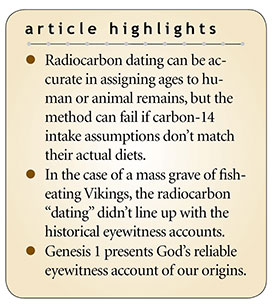 Radiocarbon dating is considered one of science’s tried-and-true methodologies. But could there be a forensic flaw in measuring carbon-14 dates using conventional methodology? Could dates assigned by that method be vulnerable to faulty assumptions that render them invalid?
Radiocarbon dating is considered one of science’s tried-and-true methodologies. But could there be a forensic flaw in measuring carbon-14 dates using conventional methodology? Could dates assigned by that method be vulnerable to faulty assumptions that render them invalid?
Indeed they can. The age assignment for certain Viking bones caused a decades-long controversy until the carbon-14 methodology used to date them was recently exposed for its flawed assumptions.1 This case demonstrates that one-size-fits-all radiocarbon dating doesn’t work.
This case demonstrates that one-size-fits-all radiocarbon dating doesn’t work. ![]()
A mass burial of 250 to 300 skeletons was discovered in the Derbyshire village of Repton, England, in the 1980s. It seemed likely they were the remains of the Scandinavian Vikings of the Great Heathen Army who wintered in Repton over a millennium ago during 873–874. Eyewitness accounts indisputably reported the army’s historical presence during the latter 800s, so many modern historians concluded that these mass-grave skeletons were those very Vikings.2 However, a team of empirical science investigators, using routine carbon-14 radiometric dating methodology, rejected that historical timeframe, arguing instead for dating the skeletons a century or so older based upon residual carbon-14 found inside the bones.1
Why would radiocarbon calculations indicate the buried warriors died during the 600s or 700s, a century or more before Derbyshire was overwhelmed by hordes of Vikings? Likewise, if radiocarbon determinations are so reliable, why is no Viking army reported as occupying Derbyshire during the 600s or 700s? This loud silence is what forensic experts call the “evidence of nothing” problem.3
Carbon-14 dating methods use assumptions.1,4 Could it be that one of the usual assumptions is invalid for measuring the time-of-death data for the Repton skeletons?
The normal radiometric dating scenario presumes that human skeletons contain organic material with steadily decaying radiocarbon that is traceable to plant photosynthesis, which incorporates atmospheric CO2 into plant carbohydrates. As herbivores eat plants, radiocarbon within photosynthesis-fixed carbohydrates metabolically incorporates into the animal’s flesh.4 By eating plants, humans acquire carbon-14 directly. By consuming plant-eating animals (cattle, sheep, goats, swine, etc.), humans ingest carbon-14 indirectly. A major assumption affecting the mathematics of radiocarbon dating is that human skeletons contain residual carbon-14 acquired predominantly from terrestrial (i.e., land-food-based) diets.1,4,5
However, a diet incorporating lots of finfish (cod, salmon, trout, herring, etc.) and/or shellfish (shrimp or crab) would nix that vital assumption.1,5 The Vikings were known for a seafood diet—specifically fish. And fish contain much less carbon-14 than land-based foods like grains, vegetables, fruits, dairy products, or livestock meats.1,2,5
Therefore, unless dietary differences are adjusted for, carbon-dated skeletons of fish-eating Vikings appear to be about a hundred years or more older than they really are. They seem to be “missing” so much of the expected carbon-14 that they are interpreted as having died centuries earlier than they actually did.1,4,5
Unique historical events such as battles, deaths, traffic accidents, or the Genesis Flood require reliable eyewitness reporting, not just empirical observations in the present. ![]()
The take-away lesson is that unique historical events such as battles, deaths, traffic accidents, or the Genesis Flood require reliable eyewitness reporting, not just empirical observations in the present such as fingerprints, rubber skid marks, or blood spatters.3,6 That’s why we need God’s eyewitness Genesis report to understand our origins.
References
- Jarman, C. L. et al. 2018. The Viking Great Army in England: New dates from the Repton charnel. Antiquity. 92 (361): 183-199.
- Haywood, J. 1995. The Penguin Historical Atlas of the Vikings. London: Penguin Books, 12-13, 62-63.
- Job 38:4. Johnson, J. J. S. 2008. The Evidence of Nothing. Acts & Facts. 37 (4): 4-5. See also Johnson, J. J. S. 2012. Genesis Critics Flunk Forensic Science 101. Acts & Facts. 41 (3): 8-9.
- Morris, J. D. 2007. The Geology Book. Green Forest, AR: Master Books, 50.
- Arneborg, J. et al. 1999. Change of Diet of the Greenland Vikings Determined from Stable Carbon Isotope Analysis and 14C Dating of Their Bones. Radiocarbon. 41 (2): 157-168.
- Johnson, J. J. S. and J. Tomkins. Blood Crying from the Ground, a Forensic Science Perspective, Illustrated by the Gruesome Killing of America’s Most Hated Woman. Presented at the Creation Research Society Conference, Dallas, Texas, July 31, 2015. See also Johnson, J. J. S. 2016. There’s Nothing Like an Eyewitness. Acts & Facts. 45 (12): 20.
* Dr. Johnson is Associate Professor of Apologetics and Chief Academic Officer at the Institute for Creation Research.














